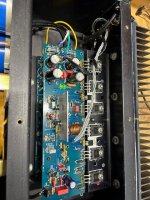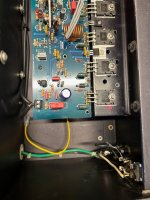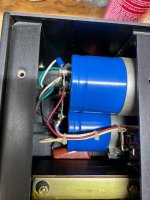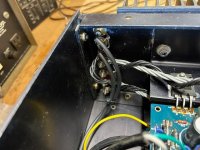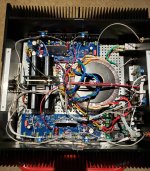Thank you for the reply. I did a little more digging to find out what "Vu" is and found that:
"Zero indicates the maximum distortion-free level that can be handled by the device."
I interpret that to mean that the standard for consumer audio equipment is to accept a 316mV input signal without distorting.
However, signals from audio sources can and do go much higher than that for those "transients". This where the 126watts and 215 watts with a 750mV input signal comes into play.
That all makes sense. Thank you! 🙂
"Zero indicates the maximum distortion-free level that can be handled by the device."
I interpret that to mean that the standard for consumer audio equipment is to accept a 316mV input signal without distorting.
However, signals from audio sources can and do go much higher than that for those "transients". This where the 126watts and 215 watts with a 750mV input signal comes into play.
That all makes sense. Thank you! 🙂
Well, that explanation isn't correct.
"0 Vu" can be any level you desire, or a standard. That is typically the characters such as 0 dBu, 0dBV, 0 dBm and more. It hasn't anything to do with maximum undistorted levels. With an amplifier it is usually the maximum rated output. In your case it was the standard consumer signal level, we use it for testing. Many power amplifiers were rated for full output at 0.775 VAC in days of yore. Later the industry pretty much discarded or ignored all standards as each company saw fit.
Consumer equipment was designed to expect a full average input level of 316 mV, it may have higher headroom. Signal peaks would be much higher as I mentioned, this is for line level inputs. Depending on the gain, different amplifiers may have various input levels for full rated output, then there are THX specifications.
Sorry, in the 1970's there would not have been any confusion.
"0 Vu" can be any level you desire, or a standard. That is typically the characters such as 0 dBu, 0dBV, 0 dBm and more. It hasn't anything to do with maximum undistorted levels. With an amplifier it is usually the maximum rated output. In your case it was the standard consumer signal level, we use it for testing. Many power amplifiers were rated for full output at 0.775 VAC in days of yore. Later the industry pretty much discarded or ignored all standards as each company saw fit.
Consumer equipment was designed to expect a full average input level of 316 mV, it may have higher headroom. Signal peaks would be much higher as I mentioned, this is for line level inputs. Depending on the gain, different amplifiers may have various input levels for full rated output, then there are THX specifications.
Sorry, in the 1970's there would not have been any confusion.
I want to let the Honeybadger builders out there know that I made a big improvement to my Badger.
I moved my Badger to a new chassis. The original chassis was too big, so I moved it to a Dissipante 03/300B 3U chassis. while I had it taken apart I made the following changes:
I can't say which of the above changes are responsible for the improved sound, but I suspect the new output transistors and the lower bias current.
I hope some builders read this post and it helps guide their build choices!
I moved my Badger to a new chassis. The original chassis was too big, so I moved it to a Dissipante 03/300B 3U chassis. while I had it taken apart I made the following changes:
- Replaced the original output transistors with MJL4281 & MJL4302 recommended by mbrennwa
- I found C1 had broken off on one channel, so I replaced C1 on both channels
- I reduced the LTP current to the recommended 3.75mA. I used to have it biased higher because I thought it would give me lower distortion.
- I replaced the mica insulators with Bergquist Sil-Pad 800.
I can't say which of the above changes are responsible for the improved sound, but I suspect the new output transistors and the lower bias current.
I hope some builders read this post and it helps guide their build choices!
NJW0281G/ NJW0302G are more linear and have a more stable HFE value throughout their practical operating range than the MJL4281 & MJL4302. The MJL4281 & MJL4302 do have better power handling capability then the NJW so I guess people can choose between the two. The MJL4281 & MJL4302 do not work with the Honey badger and the UMS. So you have to drill new mounting holes.
- Replaced the original output transistors with MJL4281 & MJL4302 recommended by mbrennwa
- I found C1 had broken off on one channel, so I replaced C1 on both channels
- I reduced the LTP current to the recommended 3.75mA. I used to have it biased higher because I thought it would give me lower distortion.
If C1 was broken off the channel wouldn't have worked at all.
Setting the LTP a little higher than 3.75mA will increase the unity gain crossover frequency and would in theory reduce distortion as the amount of open loop gain would increase. But based on my own testing using actual measurement equipment there are other factors affecting the ability of the honey badger to produce low distortion. Hence why the Wolverine was developed.
Last edited:
Yep, I used a 3U chassis and drilled my own holes.The MJL4281 & MJL4302 do not work with the Honey badger and the UMS. So you have to drill new mounting holes.
Hmm . . . Must have broken off while I was taking it apart.If C1 was broken off the channel wouldn't have worked at all.
So it sounds like I made the right decision. Also, the heatsinks are noticeably cooler.But based on my own testing using actual measurement equipment there are other factors affecting the ability of the honey badger to produce low distortion.
So don't know if right forum for troubleshooting HB?? I have one I built about 5 years ago, still working like I remembered it. But in troubleshooting other amps and learning how to use REW i have noticed that I have 60hz hum. Very low level only hear it with my ear right on speaker. Measures -75dbFS with inputs shorted. Inputs isolated from chassis, mogami coaxial with braided shield, DC power wire to boards is twisted. I do notice though that the speaker output on the board for out and ground is about 5 inches or so apart. So the output wire to speaker connection is not twisted nearly like I would like due to the separation? Not sure if that could cause a problem though. One question does R4, 5ohm function as a hum breaking resister? And if so could I try increasing to 10 ohms or so??
The yellow wire is capped off and just connected to the test point for measuring Bias. I do not use them.
Hard to tell from the pictures. I'm seeing two channels, stacked on top each other. In first picture, powers supply is at bottom of picture out of the picture? Also not 100% certain, but do you have your power supply wiring parallel to your input wiring all way down the left side of the picture?
Well had a short video to show the whole Amp but to big to load. No power and signal cros paths at one point only and about 2 Inch apart. Do you have any noise with your HB at all? Even very quiet? I have separate DC power wiring to each ch all way back to power supply caps. That caused noise in last Amp and I ended up daisy chain. Much quieter. What did you do with power to two boards?
Yeah and I might just be over reacting too. I listened to this for years and never worried about any hum. Couldn't hear any unless ear right on front of speaker. Just have a new measurement tool and looking at levels that technically should be lower compared to industry comparisons. The last amp, which was worse, I was able to improve by 40ish dB. A big difference. So just looking at other amps now.
What about R4, do yoyu understand what that is doing. Looks like HBR to me??
What about R4, do yoyu understand what that is doing. Looks like HBR to me??
Yes and I have been cognizant of that. It is a USB powered converter but I always back it up with listening for what it is measuring. Who would be the SME on the circuit itself concerning R4?
Been to long since I built it, but I'm thinking I could have mounted them vertically. Looking at the picture, the boards are pretty wide, don't know if they would have fit vertically.
- Home
- Amplifiers
- Solid State
- diyAB Amp - The "Honey Badger"
